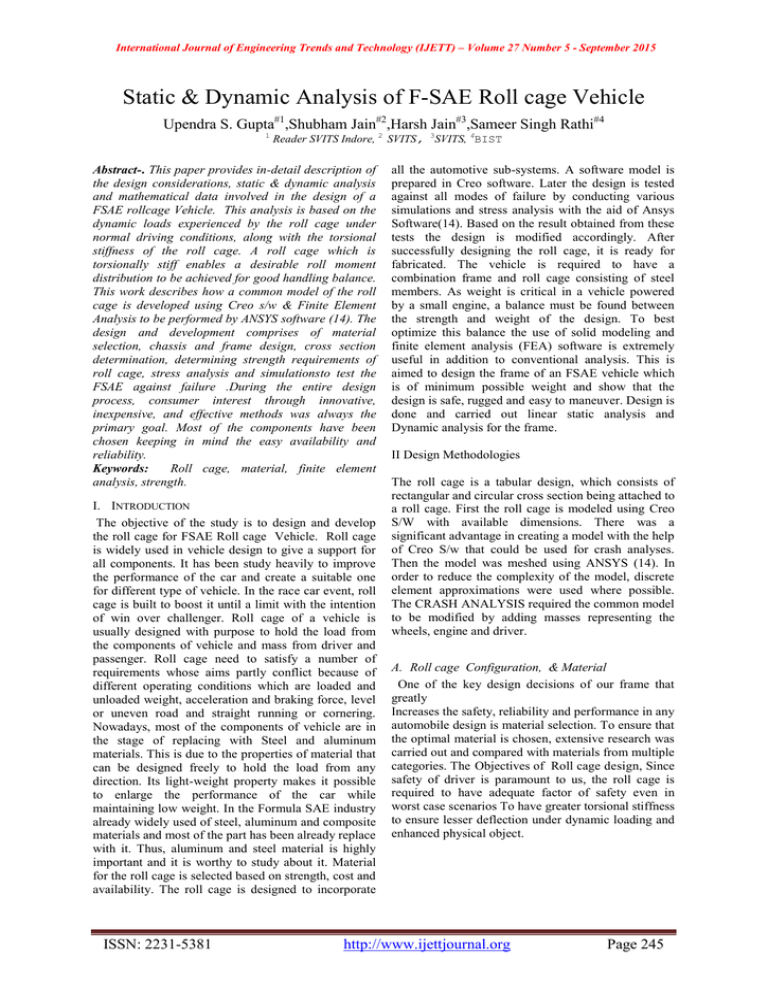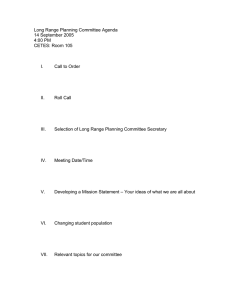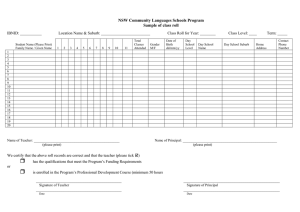Document 12913228
advertisement

International Journal of Engineering Trends and Technology (IJETT) – Volume 27 Number 5 - September 2015 Static & Dynamic Analysis of F-SAE Roll cage Vehicle Upendra S. Gupta#1,Shubham Jain#2,Harsh Jain#3,Sameer Singh Rathi#4 1 Reader SVITS Indore, 2 SVITS, 3SVITS, 4BIST Abstract-. This paper provides in-detail description of the design considerations, static & dynamic analysis and mathematical data involved in the design of a FSAE rollcage Vehicle. This analysis is based on the dynamic loads experienced by the roll cage under normal driving conditions, along with the torsional stiffness of the roll cage. A roll cage which is torsionally stiff enables a desirable roll moment distribution to be achieved for good handling balance. This work describes how a common model of the roll cage is developed using Creo s/w & Finite Element Analysis to be performed by ANSYS software (14). The design and development comprises of material selection, chassis and frame design, cross section determination, determining strength requirements of roll cage, stress analysis and simulationsto test the FSAE against failure .During the entire design process, consumer interest through innovative, inexpensive, and effective methods was always the primary goal. Most of the components have been chosen keeping in mind the easy availability and reliability. Keywords: Roll cage, material, finite element analysis, strength. I. INTRODUCTION The objective of the study is to design and develop the roll cage for FSAE Roll cage Vehicle. Roll cage is widely used in vehicle design to give a support for all components. It has been study heavily to improve the performance of the car and create a suitable one for different type of vehicle. In the race car event, roll cage is built to boost it until a limit with the intention of win over challenger. Roll cage of a vehicle is usually designed with purpose to hold the load from the components of vehicle and mass from driver and passenger. Roll cage need to satisfy a number of requirements whose aims partly conflict because of different operating conditions which are loaded and unloaded weight, acceleration and braking force, level or uneven road and straight running or cornering. Nowadays, most of the components of vehicle are in the stage of replacing with Steel and aluminum materials. This is due to the properties of material that can be designed freely to hold the load from any direction. Its light-weight property makes it possible to enlarge the performance of the car while maintaining low weight. In the Formula SAE industry already widely used of steel, aluminum and composite materials and most of the part has been already replace with it. Thus, aluminum and steel material is highly important and it is worthy to study about it. Material for the roll cage is selected based on strength, cost and availability. The roll cage is designed to incorporate ISSN: 2231-5381 all the automotive sub-systems. A software model is prepared in Creo software. Later the design is tested against all modes of failure by conducting various simulations and stress analysis with the aid of Ansys Software(14). Based on the result obtained from these tests the design is modified accordingly. After successfully designing the roll cage, it is ready for fabricated. The vehicle is required to have a combination frame and roll cage consisting of steel members. As weight is critical in a vehicle powered by a small engine, a balance must be found between the strength and weight of the design. To best optimize this balance the use of solid modeling and finite element analysis (FEA) software is extremely useful in addition to conventional analysis. This is aimed to design the frame of an FSAE vehicle which is of minimum possible weight and show that the design is safe, rugged and easy to maneuver. Design is done and carried out linear static analysis and Dynamic analysis for the frame. II Design Methodologies The roll cage is a tabular design, which consists of rectangular and circular cross section being attached to a roll cage. First the roll cage is modeled using Creo S/W with available dimensions. There was a significant advantage in creating a model with the help of Creo S/w that could be used for crash analyses. Then the model was meshed using ANSYS (14). In order to reduce the complexity of the model, discrete element approximations were used where possible. The CRASH ANALYSIS required the common model to be modified by adding masses representing the wheels, engine and driver. A. Roll cage Configuration, & Material One of the key design decisions of our frame that greatly Increases the safety, reliability and performance in any automobile design is material selection. To ensure that the optimal material is chosen, extensive research was carried out and compared with materials from multiple categories. The Objectives of Roll cage design, Since safety of driver is paramount to us, the roll cage is required to have adequate factor of safety even in worst case scenarios To have greater torsional stiffness to ensure lesser deflection under dynamic loading and enhanced physical object. http://www.ijettjournal.org Page 245 International Journal of Engineering Trends and Technology (IJETT) – Volume 27 Number 5 - September 2015 Material Yield strength Outer diameter Thickness carbon percentage Technical Parameter Front impact Side Impact Rear Impact Roll over AISI1018 (Seamless) 360 Mpa 1.” 2 mm 0.18% Max. Eqvt. Stress (Mpa) 416.75 371.74 431.9 412.8 Max. Deform at Member (mm) 1.06 1.94 2.27 7.53 Factor of safety 1.08 1.21 1.05 1.09 Table 1: Material Properties of AISI 1018 (seamless) B. Roll cage Design To begin the initial design of the frame, some design Guidelines were required to be set. They included intended Transmission, steering and suspension systems and their Placement, mounting of seat, design features and manufacturing methods. It is also required to keep a minimum clearance of 3 inches between the driver and the roll cage members. It is also necessary to keep weight of the roll cage as low as possible to achieve better acceleration. It is necessary to keep the center of gravity of the vehicle as low as possible to avoid toppling. Mounting heavier components such as engine, driver seat etc. directly on the chassis is one way of achieving low center of gravity. Also it is imperative to maintain the integrity of the structure. This is done by providing bends instead of welds which in turn reduces the cost. Table 2: Table 2: Analysis of Roll Cage by using ANSYS(14) III Finite Element Analysis The Finite Element Analysis (FEA) of the vehicle was done using ANSYS. The stress analysis was done under worst case scenarios and maximum forces were applied in the analysis. Adequate factor of safety were ensured for all the components under these worst case conditions. The FEA of Roll cage components was done using ANSYS Workbench 14. The analysis for roll cage included front impact, rear impact, side impact, rollover, front bump, rear bump and torsion. For all the analysis the weight of the vehicle is taken to be 325Kg Fig1: Finite Element Analysis of Roll Cage for Front Impact Test by using ANSYS (14) III Results & Discussion of Static & Dynamic Analysis of FSAE Roll cage A. Front Impact Test Front Impact Test was carried out assuming a vehicles having 325 kg mass and travelling with velocity of 110km/h colliding Head on with a stationary wall. The impact force was calculated using the kinetic energy transfer theory. Impact energy = (1/4) x M x (velocity)2 Work done= force x displacement Fig2 : Finite Element Analysis of Roll cage for Side Impact Test by using ANSYS (14) ISSN: 2231-5381 http://www.ijettjournal.org Page 246 International Journal of Engineering Trends and Technology (IJETT) – Volume 27 Number 5 - September 2015 clamp load of 1630.65 N, bearing force of 1000 N and 3g bump forces during the run. B.A Arms & Clamps The A-arms and the clamps are the main parts that connect the unsprung mass with the roll cage. Hence they are an important area to look and check for any possibility of failure. FEA of both was done to ensure the same. 3g bump forces were taken while analysing both. Fig3: Finite element analysis of Roll over by using ANSYS (14) IV Conclusion In the project is presented a detailed analysis of the crash behavior of the front and side impact rollcage structure that was designed to equip the formula FSAE car. The simulations performed by the finite element methods reveal some very important Facts. The design of the roll cage is improve driver safety by optimizing the roll cage by add and variation of mass in roll cage using ANSYS software. The design and position of the links between the energy absorbing structure and the car frame structure are found to be essential to determine the crash worthiness of the vehicle in case of front impact and side impact The design is first conceptualized based on personal experiences and intuition. Engineering principles and design processes are then used to verify and create a vehicle with optimal performance, safety, manufacturability, and ergonomics. The design process included using Creo and ANSYS software packages to model, simulate, and assist in the analysis of the completed vehicle. Further, software analysis shows us that the vehicle can take frontal impacts of up to 416.75 Mpa ,Rear Impact of up to 431.9 Mpa,side impacts of up to 371.74 Mpa & Roll over 412.8 Mpa. This clearly reaffirms the vehicle’s ability to withstand extreme conditions. V References [1] Design/Build of a Formula SAE Vehicle (L.Y Chan, M. Doecke, H. Lalwani, H.W Lau, T. Lau, C.C Lee, C.C Low.) [2] Numerical and Experimental Analysis of Formula SAE Chassis, With Recommendations for Future Design Iterations (The University Of Queensland) [3] Torsional Chassis Stiffness and Crashworthiness Analysis Of The University Of Leeds (2000 Formula SAE / Student Racing Car) [4] Design of the Impact Attenuator for a Formula Student Racing Car: Numerical Simulation of the Impact Crash Test (Mechanical Engineering Department, Politecnico Di Torino, Corso Duca Degli Abruzzi24, 10129 Torino, Italy) [5] Introduction to Formula SAE Suspension and Frame Design Edmund F. Gaffney Iii and Anthony R. Salinas [6] 2010 Formula SAE Rules, SAE International, USA. Fig4: Finite element analysis of Front Bump by using ANSYS (14) C. Knuckle The Knuckle undergoes various direct, shear and thrust forces during the plying of vehicle. And since we have manufactured a custom design, it becomes more necessary to ensure its safety. FEA of the knuckle was done taking in account the brake calliper ISSN: 2231-5381 http://www.ijettjournal.org Page 247



